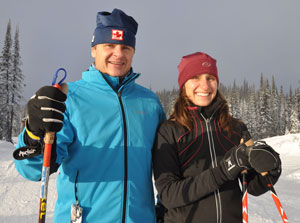
Physical fitness can keep you active well beyond normal retirement age. Joe Derochie, (left), competed in canoeing in the 1960 Summer Olympic Games in his early 20s. Now 70, he resides in Vernon, B.C., and is an avid cross-country skier and mountain bike rider. Joe's son Darren Derochie, 43, (middle) is an Olympic cross-country skier who competed in the 1992 Winter Games. Darren is club coach at Sovereign Lake Nordic Centre near Vernon, B.C. -- venue for the 2011 Masters World Cup and home club of promising athletes like national medalist Heather Mehain, 18 (right).
UBC Reports | Vol. 56 | No. 1 | Jan. 7, 2010
For many older adults, aging with chronic disease, disability and frailty requires a daily Olympian effort just to survive. Exercise training inspired by Olympic regimens can allow older adults to turn back the clock on frailty, according to researchers Gareth Jones and Jennifer Jakobi, assistant professors of Human Kinetics at UBC Okanagan.
“In many ways, frailty is a natural part of aging – it’s where we end up – but we all get there at different rates, and we move through different stages of it,” says Jones. “At some point people just can’t cope with the environment around them. Our research looks at how older adults progress towards becoming frail and what interventions, specifically exercise, might prevent people from ending up there.

UBC Okanagan Human Kinetics professors Gareth Jones and Jennifer Jakobi research how we become frail and what interventions, such as exercise, can be done to prevent frailty.
Older people who are active can have a better quality of life, Jones says. “Exercise is the best medicine to reduce the impact of chronic disease. If we don’t take the exercise medicine, we are more likely to become dependent longer, and become a greater burden to society.”
Jakobi and Jones are currently studying the physiological changes that occur as people transition through stages of frailty and how healthcare providers recognize it. They say it is possible to reduce the impact of frailty and transform frail seniors into active, healthy and independent persons through daily exercise training that improves fitness.
The Olympic movement’s motto Citius, Altius, Fortius can provide guidance for fitness for older adults:
Citius (faster) – walk briskly, pick up the pace, and increase the intensity.
Currently, the majority of Canadians over age 65 live with chronic disease, almost half live with disability and the majority are inactive. More activity is important – but Jones and Jakobi advise that, at any age, for exercise to produce fitness benefits it needs to be done for a minimum of 30 minutes most days of the week, at moderate to vigorous intensity such as a brisk walk. Start with 30 minutes and progress to 60 minutes.
The keys to building fitness are the frequency, intensity, and duration of physical activity, says Jakobi.
Altius (higher) – set higher goals.
“It is remarkable what can be achieved,” says Jones. “People think what Olympians do is out of reach, but really what they are doing is what we need to be doing in our society and in our lifestyles to maintain our health and improve our fitness.
“The only way to make a change is to add structured time into our day for exercise. We have to think about it like daily hygiene. As important as brushing your teeth morning and night, or flossing, exercise has to be structured into your day,” he says. “The Olympian prepares their body for one event in time, but you need to physically and mentally train your body to support you for the rest of your life.”
The researchers cite the example of Sister Madonna Budah, a 79-year-old Roman Catholic nun and triathlete from Spokane, Washington, who has completed 39 Ironman races and is expected to participate in the Penticton Ironman Canada again next summer at the age of 80.
Fortius (stronger) – building strength can ward off disability and keep aging muscle moving the way we want it to.
“For most older adults, it is a gradual decline and they become frail before they realize it,” says Jakobi. “You start to decline at about 30 years – but it is not recognized until cardiovascular and strength changes become functionally noticeable.”
To thwart the slow decline in function, aerobic exercise is important, says Jakobi, “but you can’t get your heart rate up if you can’t support your body weight.”
Resistance training can produce extreme gains in muscle strength and can increase a person’s ability to perform aerobic exercise – leading to better balance, or the ability to do more brisk walking, for example.
The researchers note that high-intensity resistance exercise is well tolerated by frail older adults, and even novice older exercisers will benefit from any progressive resistance training.
Strength is important as we age: a healthy 80-year-old woman, for example, may have to use most or all of her leg strength to rise from a common armless chair. The same movement would demand only a 50 per cent effort in a young, sedentary female.
“Even a 10 or 20 per cent increase in strength would be enough to postpone this 80-year-old woman from dropping below the critical threshold required for maintaining functional independence,” says Jones.
“If older adults were to adopt these Olympian values, aging may become a positive life experience rather than one that is often associated with decline,” Jones says. “We’ll see more older adults doing things we never believed they could achieve. It is remarkable how well our bodies adapt to exercise, no matter what age we are.
“Exercise is the best medicine we know,” he says. “If we can get our bodies moving and working at intensities that engender fitness we’re going to reverse the progression to frailty.”
— 30 —